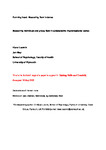Measuring individual and group flow in collaborative improvisational dance
| dc.contributor.author | Łucznik, Klara | |
| dc.contributor.author | May, Jon | |
| dc.date.accessioned | 2021-05-17T09:53:34Z | |
| dc.date.issued | 2021-06 | |
| dc.identifier.issn | 1871-1871 | |
| dc.identifier.issn | 1878-0423 | |
| dc.identifier.other | 100847 | |
| dc.identifier.uri | http://hdl.handle.net/10026.1/17122 | |
| dc.description.abstract |
This study investigated flow experience during group collaborations of creative dance improvisation, where group flow was defined as periods when most members of a group reported a flow experience. Sixteen dancers took part in the experimental sessions, performing improvisational tasks in groups of four. We chose two different types of dance task, hypothesising that dancers’ external focus upon the group's shared surroundings and awareness of others might facilitate group flow experience; while an internal focus upon one's own mental imagery might inhibit it. A novel, video-stimulated recall method to assess flow experience was used to track time patterns and shared characteristics of flow experience within the group. We also used the Flow Short Scale (FSS); thinking aloud recall; and consensual assessment of creative outcomes of activity. Our findings showed that group flow was rather rare and was more likely when a group had worked together for longer. Consequently, external focus tasks facilitated group flow only in the latter part of the session. Dancers’ reports revealed that a group in a high-flow state engaged with a task in a more complex way: sharing, transforming and supporting each other's ideas, while low-flow moments were characterised by simpler creative tools, such as mimicry. As expected, flow was positively related to the creative outcomes of the group activity. | |
| dc.format.extent | 100847-100847 | |
| dc.language | en | |
| dc.language.iso | en | |
| dc.publisher | Elsevier | |
| dc.subject | Flow | |
| dc.subject | Group creativity | |
| dc.subject | Dance | |
| dc.subject | Improvisation | |
| dc.title | Measuring individual and group flow in collaborative improvisational dance | |
| dc.type | journal-article | |
| dc.type | Journal Article | |
| plymouth.author-url | https://www.webofscience.com/api/gateway?GWVersion=2&SrcApp=PARTNER_APP&SrcAuth=LinksAMR&KeyUT=WOS:000663499100008&DestLinkType=FullRecord&DestApp=ALL_WOS&UsrCustomerID=11bb513d99f797142bcfeffcc58ea008 | |
| plymouth.volume | 40 | |
| plymouth.publication-status | Published | |
| plymouth.journal | Thinking Skills and Creativity | |
| dc.identifier.doi | 10.1016/j.tsc.2021.100847 | |
| plymouth.organisational-group | /Plymouth | |
| plymouth.organisational-group | /Plymouth/Faculty of Health | |
| plymouth.organisational-group | /Plymouth/Faculty of Science and Engineering | |
| plymouth.organisational-group | /Plymouth/REF 2021 Researchers by UoA | |
| plymouth.organisational-group | /Plymouth/REF 2021 Researchers by UoA/UoA04 Psychology, Psychiatry and Neuroscience | |
| plymouth.organisational-group | /Plymouth/REF 2021 Researchers by UoA/UoA04 Psychology, Psychiatry and Neuroscience/UoA04 REF peer reviewers | |
| plymouth.organisational-group | /Plymouth/Research Groups | |
| plymouth.organisational-group | /Plymouth/Research Groups/Centre for Brain, Cognition and Behaviour (CBCB) | |
| plymouth.organisational-group | /Plymouth/Research Groups/Centre for Brain, Cognition and Behaviour (CBCB)/Behaviour | |
| plymouth.organisational-group | /Plymouth/Research Groups/Institute of Health and Community | |
| plymouth.organisational-group | /Plymouth/Users by role | |
| plymouth.organisational-group | /Plymouth/Users by role/Academics | |
| dcterms.dateAccepted | 2021-05-16 | |
| dc.rights.embargodate | 2022-5-18 | |
| dc.identifier.eissn | 1878-0423 | |
| dc.rights.embargoperiod | Not known | |
| rioxxterms.versionofrecord | 10.1016/j.tsc.2021.100847 | |
| rioxxterms.licenseref.uri | http://www.rioxx.net/licenses/all-rights-reserved | |
| rioxxterms.licenseref.startdate | 2021-06 | |
| rioxxterms.type | Journal Article/Review |


